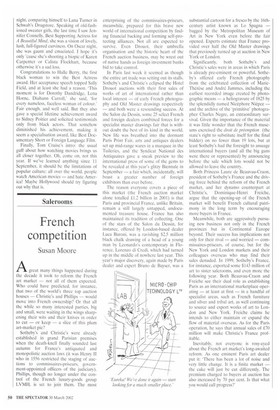French competition
Susan Moore
Agreat many things happened during the decade it took to reform the French art market — not all of them expected. Who could have predicted. for instance, that two of the world's three top auction
houses Christie's and Phillips — would move into French ownership? Or that all the while so many interested parties, big and small, were waiting in the wings sharpening their wits and their knives in order to cut — or keep — a slice of this plum art-market pie?
Sotheby's and Christie's were already established in grand Parisian premises when the death-knell finally sounded last autumn for France's antiquated and monopolistic auction laws (it was Henry II who in 1556 restricted the staging of auctions to commissaires-priseurs, government-appointed officers of the judiciary). Phillips, though no longer under the control of the French luxury-goods group LVMH, is set to join them. The most enterprising of the commissaires-priseurs, meanwhile, prepared for this brave new world of international competition by finding financial backing and forming self-protecting alliances. Not all are expected to survive. Even Drouot, their umbrella organisation and the historic heart of the French auction business, may be wrest out of native hands as foreign investment banks bid to take control.
In Paris last week it seemed as though the entire art trade was setting out its stalls. Sotheby's and Christie's eclipsed the Hotel Drouot auctions with their first sales of works of art of international rather than local interest — of early French photography and Old Master drawings respectively — and both were a resounding success. At the Salon du Dessin, some 25 select French and foreign dealers combined forces for a specialist master drawings fair that is without doubt the best of its kind in the world. New life was breathed into the dormant Paris Print Fair, arts and antiques dealers set up mid-range wares in a marquee in the Tuileries, and the Syndicat National des Antiquaires gave a sneak preview to the international press of some of the gems to be revealed at this year's glitzy Biennale in September — a fair which, incidentally, will boast a greater number of foreign exhibitors than ever before.
The reason everyone covets a piece of this market (the French auction market alone totalled £L2 billion in 2001) is that Paris and provincial France, unlike Britain, remain a still largely untapped, undocumented treasure house. France has also maintained its tradition of collecting. One of the stars of the Salon du Dessin, for instance, offered by London-based dealer Luca Baroni, was a ravishing $2.5 million black chalk drawing of a head of a young man by Leonardo's contemporary in Florence, Lorenzo di Credi, which had turned up in the middle of nowhere last year. This year's major discovery, again made by Paris dealer and expert Bruno de Bayser, was a substantial cartoon for a fresco by the 16thcentury artist known as Lo Spagna — bagged by the Metropolitan Museum of Art in New York even before the fair opened. Experts estimate that France provided over half the Old Master drawings that previously turned up at auction in New York or London.
Significantly, both Sotheby's and Christie's sales were in areas in which Paris is already pre-eminent or powerful. Sotheby's offered early French photography from the celebrated collection of MarieTherese and Andre Jammes, including the earliest recorded image created by photographic means — a heliogravure of 1825 by the splendidly named Nicephore Niepce — and the archive of the 'primitive' photographer Charles Negre, an extraordinary survival. Given the importance of the material it was little wonder that the French museums exercised the droit de preemption (the state's right to substitute itself for the final bidder) on no fewer than 19 lots, but at least Sotheby's had the foresight to assuage international buyers (and all the big guns were there or represented) by announcing before the sale which lots would not be allowed to leave the country.
Both Princess Laure de Beauvau-Craon, president of Sotheby's France and the driving force behind the reform of the French market, and her dynamo counterpart at Christie's, Dominique-Henri Freiche, argue that the opening-up of the French market will benefit French cultural patrimony in the long term by encouraging more buyers in France.
Meanwhile, both are aggressively pursuing new business not only in the French provinces but in Continental Europe beyond. Their success has implications not only for their rival — and worried — coinmissaires-priseurs, of course, but for the New York and London markets and their colleagues overseas who may find their sales denuded. In 1999. Sotheby's France, for instance, exported some $143 million of art to sister salerooms, and even more the following year. Both Beauvau-Craon and Freiche see their dual role as establishing Paris as an international marketplace operating — at least at first — in a handful of specialist areas, such as French furniture and silver and tribal art, as well continuing to source and export works of art to London and New York. Freiche claims he intends to either maintain or expand the flow of material overseas. As for the Paris operation, he says that annual sales of £70 million will make Christie's France profitable.
Inevitably, not everyone is rosy-eyed about the French art market's long-awaited reform. As one eminent Paris art dealer put it: 'There has been a lot of noise and very little change. It is a finite market — the cake will just be cut differently. The premium charged to buyers at auction has also increased by 70 per cent. Is that what you would call progress?'


































































 Previous page
Previous page